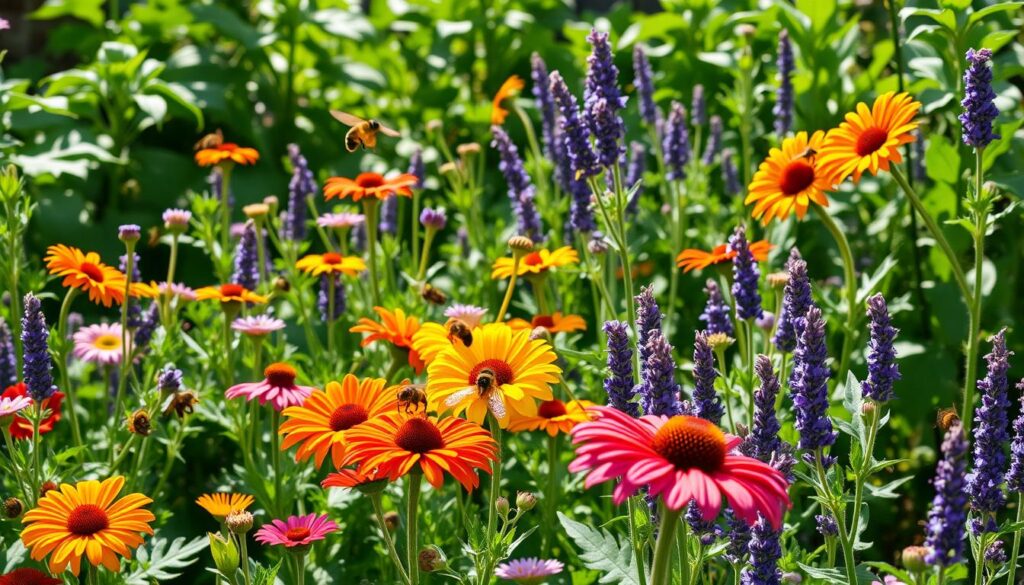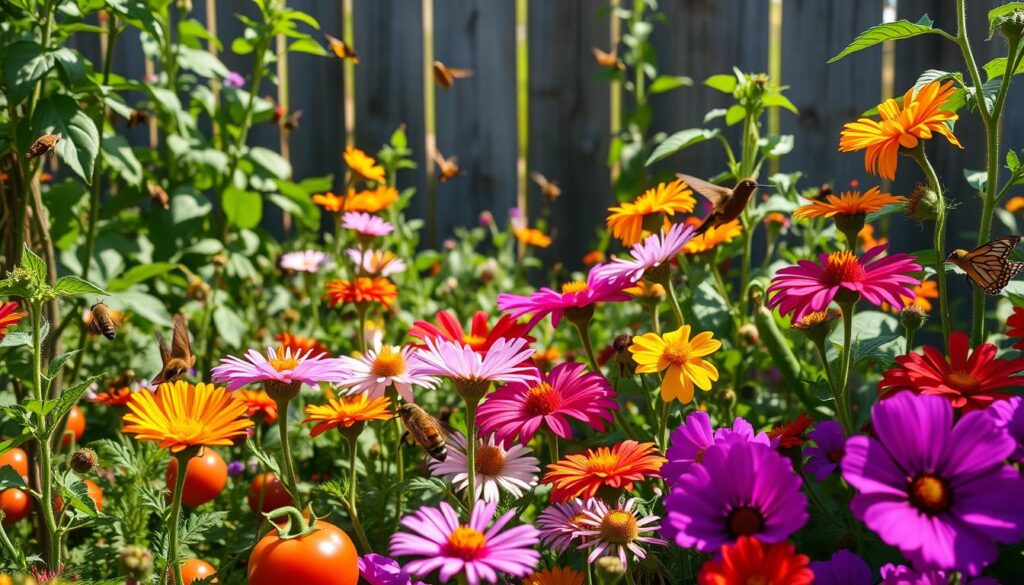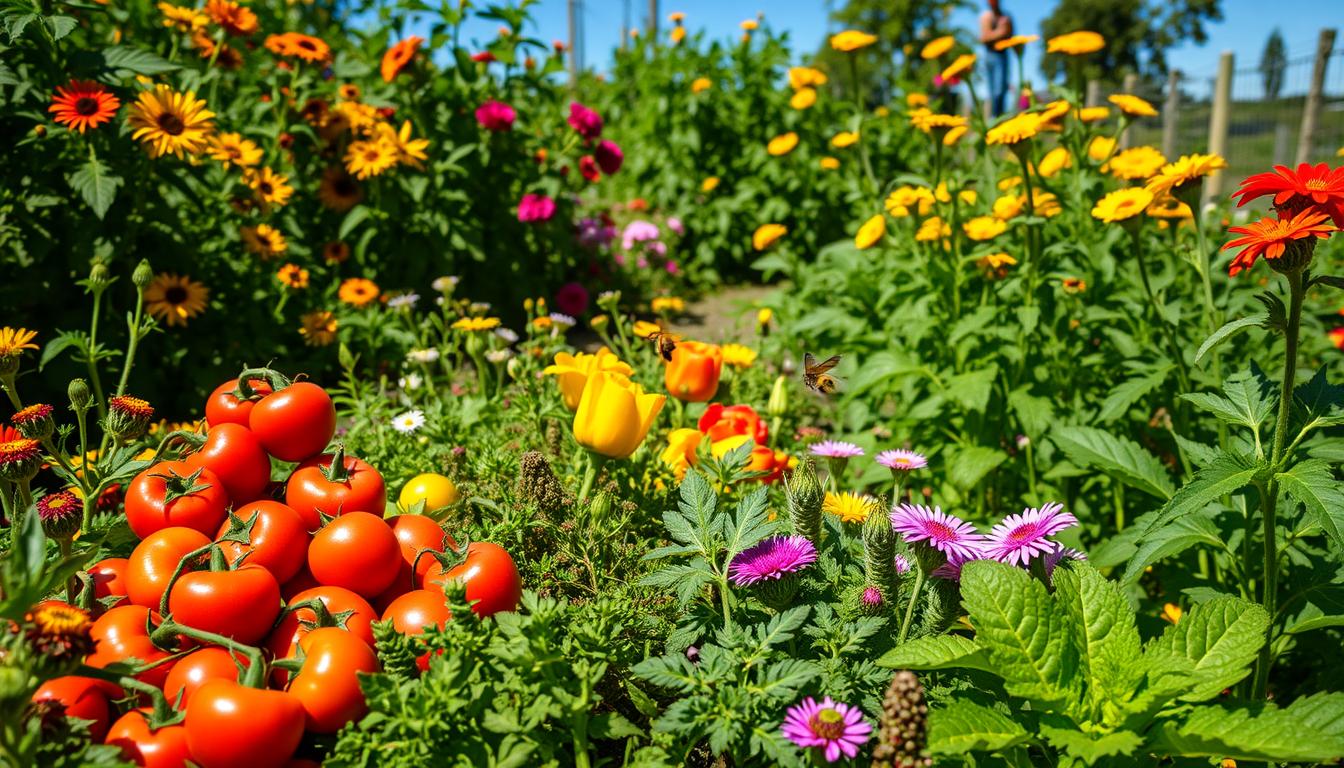I love gardening and know how important pollinators are. They help our gardens grow healthy and strong. In this guide, I’ll show you how to make your garden a haven for pollinators. This will help your crops grow better, support nature, and make your garden more beautiful.
Key Takeaways
- Understand the vital role of pollinators in fruit and vegetable production.
- Learn how to create a pollinator-friendly habitat in your vegetable garden.
- Discover the best nectar-rich flowers and native plants to attract pollinators.
- Implement natural pest control methods to protect pollinators.
- Observe and monitor pollinator activity to maintain a diverse and sustainable garden.
The Importance of Pollinators in Vegetable Gardens
Pollinators are key to a successful vegetable garden. They help pollinate many fruits and veggies, leading to healthy crops and more food. By drawing pollinators to your garden, you can make it a lively, thriving place.
Pollinators and Their Role in Fruit and Vegetable Production
Bees, butterflies, and hummingbirds are vital for plant reproduction. They move pollen, helping plants make fruit and seeds. Without them, many veggies wouldn’t grow as well.
Benefits of Attracting Pollinators to Your Garden
- Improved pollination for your vegetable crops, leading to higher yields and healthier produce
- Increased biodiversity, supporting a more balanced and resilient ecosystem in your garden
- A visually stunning and vibrant garden filled with the colors and movements of diverse pollinators
- Contribution to the conservation of threatened pollinator species, such as bees and butterflies
Knowing how pollinators help your vegetable garden can guide your actions. It helps you attract pollinators and boost crop production. This approach makes your garden a healthy, eco-friendly space.
Creating a Pollinator-Friendly Habitat
To attract pollinators and make your vegetable garden thrive, create a pollinator-friendly habitat. This means adding nectar-rich flowers, reliable water sources, and using sustainable gardening practices. These steps turn your garden into a vibrant oasis for many beneficial insects and animals.
Choosing nectar-rich plants is key. Pick flowers that bloom at different times to keep nectar and pollen flowing. Native plants are great because they fit well with local climates and soil, needing less care and helping native pollinators.
Also, your garden needs reliable water sources. A shallow birdbath or small pond is perfect for pollinators to safely drink. Add stones or logs for perches and resting spots.
Using sustainable gardening practices is vital. Avoid pesticides and focus on soil health. This protects your garden’s ecosystem and lets pollinators thrive without harm.
“By creating a pollinator-friendly garden, you’re not only beautifying your outdoor space but also making a valuable contribution to the conservation of these essential creatures.” – Pollinator Partnership
Turning your garden into a pollinator-friendly oasis is rewarding and helps your local ecosystem. Follow these tips and use sustainable gardening practices to attract many pollinators and boost your vegetable garden’s productivity.
Selecting Pollinator-Attractive Plants
When planning your vegetable garden, it’s key to pick plants that attract pollinators. These hardworking creatures are crucial for growing many fruits and veggies. So, it’s important to make your garden welcoming to them.
Choosing Nectar-Rich Flowers
Pollinators like bees, butterflies, and hummingbirds love nectar-rich flowers. These flowers give them the energy they need to survive the growing season. Lavender, purple coneflowers, and zinnias are great choices for these pollinator-attractive plants.
Incorporating Native Plants
It’s also smart to add native plants for pollinators to your garden. These plants are made for local pollinators and offer them important resources all season. Black-eyed Susans, Milkweed, and Joe-Pye Weed are excellent native garden plants for pollinators.
By picking a mix of nectar-rich flowers and native plants, you can make your vegetable garden a lively haven for pollinators. This benefits both the pollinators and your garden’s harvest of fruits and veggies.
| Nectar-Rich Flowers | Native Plants for Pollinators |
|---|---|
| Lavender | Black-eyed Susans |
| Purple Coneflowers | Milkweed |
| Zinnias | Joe-Pye Weed |

“By creating a garden that caters to the needs of pollinators, you’re not only helping to sustain these vital creatures but also ensuring the long-term productivity of your vegetable garden.”
Providing Water Sources for Pollinators
Attracting pollinators to your garden is more than just planting flowers. Bees, butterflies, and hummingbirds need water to survive. Adding water features to your garden helps these creatures stay hydrated.
Setting up a bird bath or shallow dish with clean water is a great idea. Place these water sources around your garden for easy access. Adding stones or pebbles makes the spot more inviting for pollinators.
Creating a dripping water source, like a faucet or small fountain, is another option. The sound of dripping water attracts pollinators. Make sure the water is clean and free of debris for their health.
Offering different water sources is key. By adding pollinator water features to your garden, you attract many pollinators. This supports their health and well-being.
Remember, providing water sources for pollinators is just part of creating a pollinator-friendly garden. Use pollinator-attractive plants and avoid harmful pesticides. This way, your garden becomes a haven for these vital creatures.
Avoiding Pesticides and Chemical Deterrents
We have a big responsibility to protect our garden’s ecosystem. Pesticides and chemicals harm pollinators, upsetting the natural balance. Instead, let’s find natural ways to keep pests away that are safe for pollinators.
Natural Pest Control Methods
There are many ways to fight pests in your garden without harming the environment. These methods protect pollinators and make your garden stronger and more sustainable.
- Introduce beneficial insects: Attract ladybugs, lacewings, and praying mantises to your garden. They eat pests, keeping your plants healthy.
- Use organic, plant-based pesticides: Choose natural pesticides like neem oil or insecticidal soaps. They’re safer for pollinators and work well against pests.
- Encourage biodiversity: Plant different flowers and herbs. They attract many beneficial insects, creating a balanced ecosystem.
- Implement physical barriers: Use row covers, mesh netting, or diatomaceous earth to keep pests away from your plants without chemicals.
By using these natural pest control methods, you can have a thriving garden. You’ll avoid pesticides for pollinators and support organic gardening for pollinators. This way, you protect pollinators and make your garden healthier and more sustainable.
How to Attract Pollinators to Your Vegetable Garden
Attracting bees, butterflies, and hummingbirds to your garden is key for a good harvest. By using certain strategies, you can make your garden a welcoming place for these important visitors.
Planting a variety of nectar-rich flowers is a smart move. This keeps pollinators fed all season long. Native plants are great too, as they fit well in local areas and need less care.
Adding water sources like a birdbath or a dripping faucet is also helpful. These spots let pollinators drink and cool off when it’s hot.
| Pollinator-Attracting Plants | Pollinator Preferences |
|---|---|
| Sunflowers, Zinnias, Cosmos | Bees |
| Milkweed, Lantana, Butterfly Bush | Butterflies |
| Trumpet Vine, Fuchsia, Salvia | Hummingbirds |
By making your garden diverse and free of pesticides, you’ll see more pollinators. This will help your vegetables grow better.
“Attracting pollinators to your garden is a win-win situation – you get to enjoy their beauty and they get to help your plants thrive.”
Even small changes can help a lot in attracting pollinators to your vegetable gardens. Start using these tips now and watch your garden come alive with pollinators.

Maintaining a Diverse and Sustainable Garden
To create a thriving garden, you need a few key strategies. Using crop rotation and companion planting helps make your garden diverse and sustainable. This approach supports many pollinators all season long.
Crop Rotation for Pollinators
Rotating your crops is good for your soil and keeps pests away. It also helps pollinators by providing them with food all season. This way, you support a healthy mix of bees, butterflies, and other pollinators.
Companion Planting for Pollinators
Planting different plants together is another smart move. Adding pollinator-attractive plants like marigolds and lavender makes your garden beautiful and beneficial. It attracts a variety of pollinators, making your garden a welcoming place for them.
| Crop Rotation for Pollinators | Companion Planting for Pollinators |
|---|---|
|
|
By using these methods, you can grow a diverse and sustainable vegetable garden. Your garden will not only give you plenty of food but also be a great home for pollinators. This helps your local ecosystem stay healthy and strong.
Creating Nesting Sites for Pollinators
Creating nesting sites is key to a pollinator-friendly garden. Solitary bees, butterflies, and other insects need safe places to reproduce. Bee houses and insect hotels provide these spaces, boosting your garden’s biodiversity and productivity.
Bee Houses and Insect Hotels
Bee houses and insect hotels mimic natural nesting sites. You can make them from wooden blocks, bamboo, or even recycled materials. They come in various sizes and shapes to meet different pollinators’ needs.
- Bee houses are perfect for solitary bees like mason bees and leafcutter bees.
- Insect hotels offer shelter for lacewings, ladybugs, and some butterflies and moths.
Place your bee houses or insect hotels in a sunny spot near your garden. This ensures pollinators can easily find the resources they need to thrive.
“Creating nesting sites for pollinators is a simple and effective way to support these vital creatures and ensure the long-term sustainability of your vegetable garden.”
| Bee House Features | Insect Hotel Features |
|---|---|
|
|
Observing and Monitoring Pollinator Activity
Watching pollinators in your garden is key to knowing how well your garden works. It shows you what’s working and what needs tweaking. By tracking different pollinators and their visits, you learn more about your garden’s ecosystem.
It’s fun to watch bees, butterflies, and other insects in your garden. Sit quietly and see them move from flower to flower. Notice which insects visit which plants.
- Identify the different pollinator species in your garden, such as honeybees, bumblebees, solitary bees, hummingbirds, and butterflies.
- Note the times of day when you observe the most pollinator activity and which plants they are visiting.
- Keep a record of any changes in pollinator populations or behaviors over the course of the season.
Collecting data on pollinators can be more structured. Create a spot in your garden for counting pollinators. This helps track your garden’s health over time.
| Pollinator Species | Visitation Frequency | Preferred Plant Species |
|---|---|---|
| Honeybee | High | Lavender, Sunflower, Sage |
| Bumblebee | Moderate | Borage, Thistle, Snapdragon |
| Monarch Butterfly | Low | Milkweed, Coneflower, Zinnia |
By watching pollinators, you learn about your garden’s complex relationships. This knowledge helps you make better choices for your garden. It keeps your garden healthy and sustainable for pollinators.
“The true wealth of a nation lies in the health and well-being of its pollinators.”
Educating Others About Pollinator Conservation
As you work to attract pollinators to your garden, think about sharing what you’ve learned. Educating your community about pollinators is key. It helps spread awareness and conservation efforts.
Hosting community events is a great way to raise awareness for pollinators. You can have workshops, garden tours, or talks. These events show the good of pollinator-friendly gardens. They encourage others to make their own spaces welcoming to pollinators.
You can also use social media to share your passion for pollinator conservation. Post articles, videos, and resources about pollinators. Explain how they help our ecosystem and how we can support them. Ask your followers to share your posts and get involved.
Remember, teaching others about pollinator conservation is rewarding and crucial for our planet’s health. By inspiring your community, you help create a more sustainable future.
“The fate of the butterfly is a harbinger to the fate of humanity.” – Dr. Homathera Sen
Through community outreach and educational initiatives, you can make a big difference. By sharing your knowledge and passion, you empower others. They can then make a real difference in their gardens and communities.
Conclusion
By following the strategies in this guide, you can create a thriving garden that supports biodiversity. This will also boost your crop yields. Always observe and adapt your practices to meet the needs of local pollinators.
The main points from this article are crucial. They include providing diverse nectar-rich plants and creating nesting habitats. Also, reducing harmful pesticide use is key. These steps can greatly help attract and support pollinators, which are vital for your garden’s health and productivity.
Together, we can positively impact our gardens and the natural world. By using these pollinator-friendly strategies, you’ll enjoy a bountiful harvest. You’ll also help conserve these vital species.



Leave a Reply